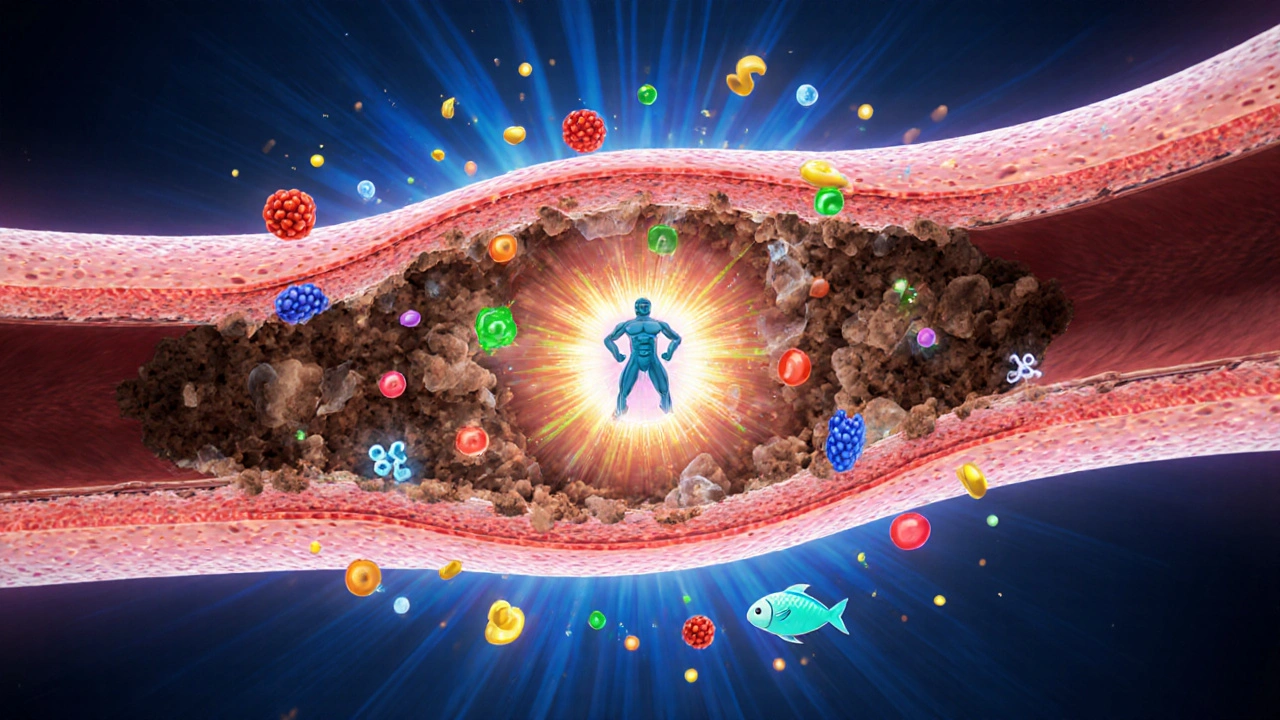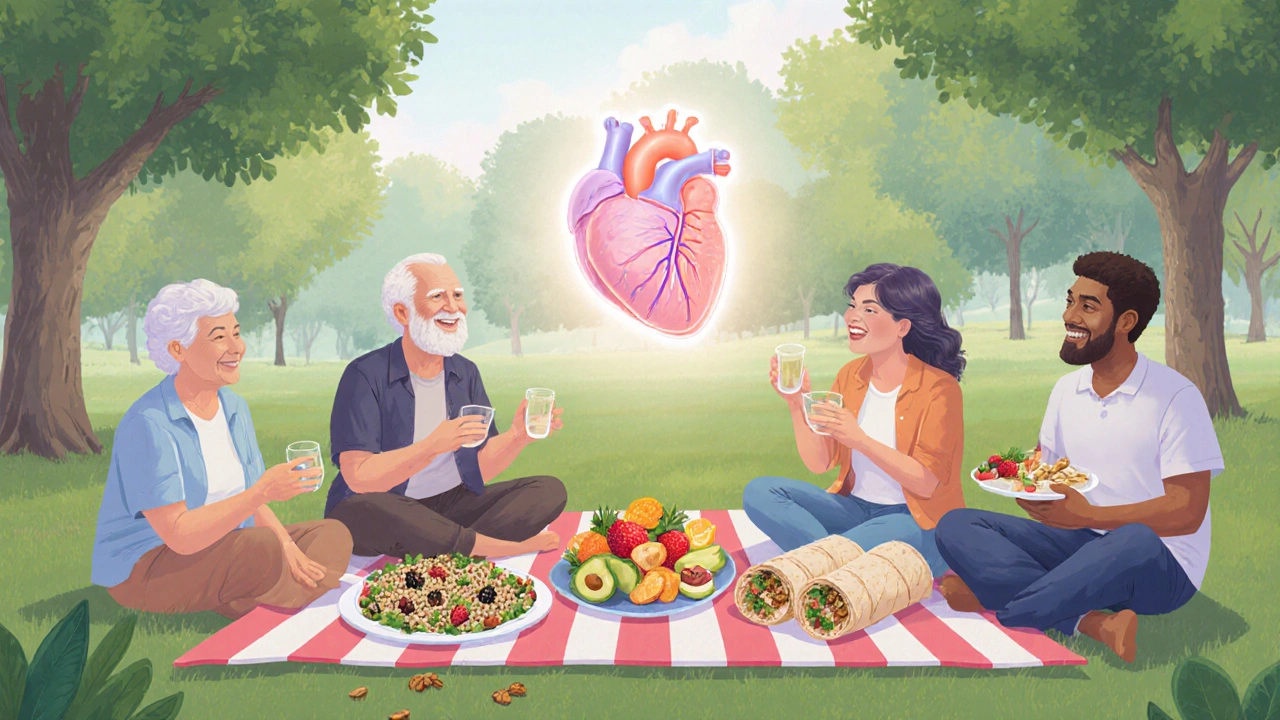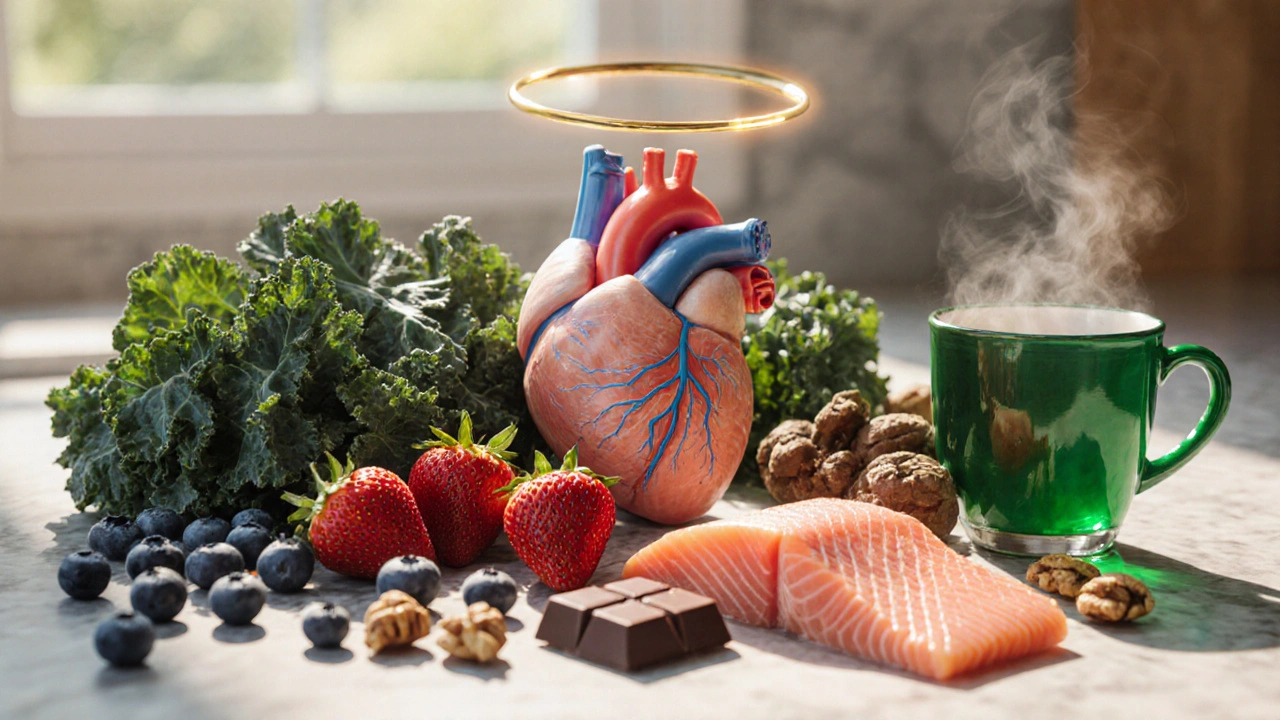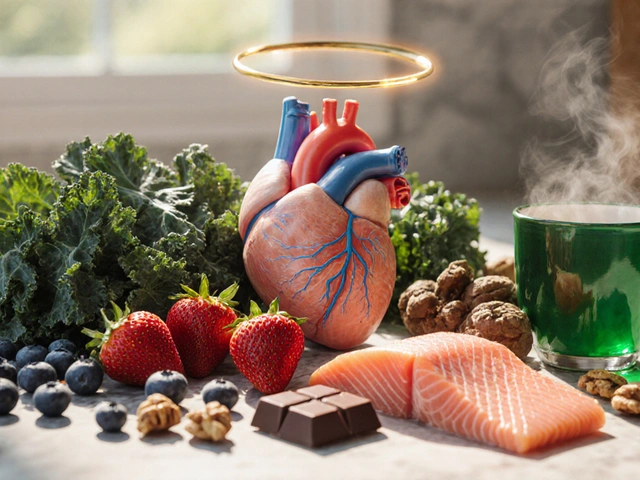Antioxidant Intake Calculator
Enter your daily food intake to calculate your estimated antioxidant value (ORAC units) and compare it to recommendations for heart health.
Coronary artery disease (CAD) kills more lives than any other condition in the United States. Yet most people think of CAD as something you inherit or that shows up only after decades of bad habits. The truth is that the early stages of a clogged artery are driven by tiny chemical attacks that you can blunt with the right foods and lifestyle choices. This article explains how antioxidants fight those attacks, what the research says, and how you can use them without falling into the hype trap.
Key Takeaways
- Oxidative stress is a central driver of plaque formation in coronary arteries.
- Antioxidants neutralize free radicals, reduce LDL oxidation, and support endothelial health.
- Whole‑food sources (berries, nuts, leafy greens) consistently outperform isolated supplement pills in trials.
- Vitamin C, vitamin E, and polyphenol‑rich foods have the strongest evidence for heart‑protective effects.
- Balance is crucial - megadoses can interfere with medication and other nutrients.
What Are Antioxidants?
Antioxidants are molecules that donate electrons to unstable free radicals, stabilizing them and preventing chain reactions that damage cells. They come from two main sources: endogenous enzymes your body produces (like superoxide dismutase) and dietary compounds found in fruits, vegetables, nuts, and spices. The most studied dietary antioxidants include vitamin C, vitamin E, carotenoids, flavonoids, and various polyphenols.
Each antioxidant has a unique chemistry, but they share the property of being able to scavenge reactive oxygen species (ROS) such as superoxide anion, hydrogen peroxide, and hydroxyl radicals. By keeping ROS levels in check, antioxidants protect proteins, DNA, and especially the lipids that line your blood vessels.
Understanding Coronary Artery Disease
Coronary artery disease is a condition where plaque builds up inside the arteries that feed the heart muscle, restricting blood flow and increasing the risk of heart attacks
. The disease follows a predictable path: endothelial injury → lipid accumulation → inflammation → plaque growth → possible rupture.Two culprits kick‑start this cascade: high levels of low‑density lipoprotein (LDL) cholesterol and oxidative stress. When LDL particles linger near the arterial wall, ROS transform them into oxidized LDL (oxLDL). OxLDL is highly inflammatory; it draws white blood cells, triggers foam cell formation, and accelerates plaque development.
How Oxidative Stress Fuels Plaque
Oxidative stress occurs when the production of free radicals outpaces the body’s antioxidant defenses, leading to cellular damage
. Sources of excess ROS include smoking, high‑glycemic meals, chronic inflammation, and even intense exercise without proper recovery.When oxidative stress is chronic, it does three things that are deadly for arteries:
- LDL Oxidation: Free radicals modify LDL particles, making them more likely to be taken up by macrophages and turned into foam cells.
- Endothelial Dysfunction: The inner lining of the vessel loses its ability to produce nitric oxide, a vasodilator that also inhibits platelet aggregation.
- Inflammatory Signaling: Oxidized lipids trigger cytokine release, fostering a sticky environment that draws more immune cells.
Breaking any of these steps can slow or reverse early atherosclerosis, and that’s where antioxidants step in.

The Biological Mechanisms Behind Antioxidant Protection
Antioxidants intervene at multiple points:
- Free‑Radical Scavenging: By donating electrons, antioxidants neutralize superoxide, hydroxyl, and peroxyl radicals before they attack LDL.
- Regeneration of Other Antioxidants: Vitamin C can recycle oxidized vitamin E back to its active form, creating a synergistic protective network.
- Improvement of Endothelial Function: Polyphenols such as resveratrol boost nitric oxide synthase activity, enhancing vasodilation.
- Anti‑Inflammatory Effects: Flavonoids down‑regulate NF‑κB, a transcription factor that drives inflammatory cytokine production.
Because the heart’s blood vessels are constantly exposed to shear stress and occasional spikes in ROS after meals, a steady supply of antioxidants helps maintain a healthy balance.
What the Research Says
Large epidemiological studies and randomized controlled trials (RCTs) have painted a nuanced picture. Observational data consistently link high intake of antioxidant‑rich foods with lower CAD incidence. However, supplement‑only trials often show modest or no benefit, suggesting that the food matrix matters.
| Antioxidant | Primary Food Sources | Typical Effective Dose (Study‑Based) | Evidence Strength | Key Cardiovascular Findings |
|---|---|---|---|---|
| Vitamin C | Citrus fruits, strawberries, broccoli | 500mg/day | Moderate | Reduces oxidative LDL, modest BP drop |
| Vitamin E (α‑tocopherol) | Nuts, seeds, vegetable oils | 200IU/day | Low‑to‑moderate | Mixed results; high doses may increase bleeding risk |
| Polyphenols (e.g., resveratrol) | Red grapes, dark chocolate, peanuts | 150mg/day | Strong (when from whole foods) | Improves endothelial function, lowers CRP |
| Flavonoids (quercetin) | Onions, apples, kale | 100mg/day | Moderate | Decreases arterial stiffness |
| Selenium | Brazil nuts, seafood | 55µg/day | Low | Antioxidant enzyme co‑factor; limited direct CAD data |
Key takeaways from the table:
- Whole‑food sources consistently rank higher than isolated pills.
- Benefits plateau around the doses shown; mega‑doses rarely add extra protection.
- Combining several antioxidants (vitamin C + polyphenols) yields synergistic effects.
How to Build an Antioxidant‑Rich Diet
Rather than chasing supplements, aim for a colorful plate. Here’s a pragmatic daily blueprint:
- Start with a breakfast bowl of oatmeal topped with blueberries (rich in anthocyanins) and a handful of walnuts (vitamin E).
- Mid‑morning snack: an orange or a kiwi for a vitamin C boost.
- Lunch: mixed leafy greens (spinach, kale) dressed with olive oil and lemon juice, plus grilled salmon (provides selenium).
- Afternoon: a small square of dark chocolate (≥70% cacao) or a handful of dried apricots.
- Dinner: stir‑fried bell peppers, broccoli, and quinoa, seasoned with turmeric (another polyphenol) and a sprinkle of sesame seeds.
- Hydration: green tea or hibiscus tea a couple of times a day for additional flavonoids.
If you’re a vegetarian or have dietary restrictions, swap animal‑based selenium sources for Brazil nuts (2‑3 per day) and include legumes for protein.
Supplement Pitfalls and Safety Tips
Supplements can fill gaps, but they’re not a magic bullet. Common mistakes include:
- Megadoses: Taking 1,000mg+ of vitamin C or 1,000IU+ of vitamin E can cause gastrointestinal upset or interfere with blood thinners.
- Single‑Nutrient Focus: Relying only on vitamin E ignores the complementary role of vitamin C and polyphenols.
- Interaction with Medications: High‑dose antioxidants may blunt the effects of statins or antihypertensives; always discuss with a physician.
A safe approach is to choose a balanced multivitamin that supplies 100‑150% of the RDA, and let foods supply the higher, synergistic doses.
Bottom Line Recommendations
For most adults looking to lower their CAD risk, the evidence points to two actionable steps:
- Eat a rainbow of fruits and vegetables every day, prioritizing berries, citrus, leafy greens, and cruciferous veggies.
- Include healthy fats (olive oil, nuts, fatty fish) that carry fat‑soluble antioxidants like vitamin E.
If you have specific risk factors-high LDL, hypertension, or a family history of early heart disease-consider adding a modest vitamin C supplement (500mg) and a polyphenol‑rich beverage (green tea or red wine, if appropriate) after consulting your doctor.

Frequently Asked Questions
Can antioxidants reverse existing plaque?
They can’t melt plaque, but studies show that a diet high in antioxidants can stabilize existing plaques, making them less likely to rupture. Combined with cholesterol‑lowering therapy, this can translate into fewer heart attacks.
Is a vitamin E supplement worth taking?
In isolation, vitamin E pills haven’t shown a clear benefit and may increase bleeding risk at high doses. Getting vitamin E from nuts, seeds, and vegetable oils is safer and works better with other antioxidants.
How much fruit should I eat to get enough antioxidants?
Aim for at least 2‑3 cups of fruit per day. A cup of berries, a medium orange, and a banana cover a wide spectrum of vitamins and polyphenols.
Do I need to test my antioxidant levels?
Routine testing isn’t necessary for most people. Focus on a balanced diet; only consider labs if you have a specific metabolic disorder or are on high‑dose supplement regimens.
Can antioxidants affect my cholesterol medication?
Most antioxidants are safe with statins, but high‑dose niacin (a B‑vitamin with antioxidant properties) can raise liver enzymes. Always tell your doctor about any supplements you add.



Chris Fulmer
September 30, 2025 AT 18:33Hey everyone, I’ve been looking into the antioxidant calculator and it’s actually pretty handy. It gives you a quick snapshot of how many ORAC units you’re racking up in a day. If you’re hitting the 50‑70% range, you’re on the right track, but pushing past 100% can be a nice safety net. Adding a handful of berries or a cup of tea can shave a few points off that gap. Keep an eye on portion sizes, because the numbers can balloon fast with nuts and chocolate.
Dan Dawson
September 30, 2025 AT 19:56Got the tool and it works fine. I just pop in my daily fruit and veg amounts and it spits out a number. No frills no commas just the facts. If you’re under 50% you need more greens. That’s it.
Lawrence Jones II
September 30, 2025 AT 21:20From a biochemical standpoint, the ORAC metric quantifies the radical‑quenching capacity of phytochemicals, essentially reflecting the electron‑donor potential (⚡). When you ingest polyphenol‑rich matrices, you engage the Nrf2‑Keap1 axis, upregulating endogenous antioxidant enzymes. The calculator abstracts this complexity into a single figure, which, while reductive, is useful for macro‑tracking. Remember, bioavailability hinges on matrix effects, not just isolated ORAC values. 🚀
Robert Frith
September 30, 2025 AT 21:53Yo Chris you sound like you’re braggin about some internet toy. Real life heart health ain’t about ticking boxes on a fancy calculator. You need to stop sugar addiction and quit smoking, not just count berries. People are fooled by this hype and think they’re safe.
Albert Gesierich
September 30, 2025 AT 22:43Dan, the sentence “If you’re under 50% you need more greens.” should have a comma after “50%” for proper clause separation. Also, “frills” is plural, so “no frills” is fine, but consider “no frills, just the facts.” for clarity. Minor tweaks, but the point stands.
Brad Tollefson
September 30, 2025 AT 23:33Lawrence, your explanation is spot on, though “electron‑donor” should be “electron‑donor”. Also, “Nrf2‑Keap1 axis” is correctly capitalized, but you might want to add a hyphen to “bio‑availability”. Small typo aside, great summary.
Paul van de Runstraat
October 1, 2025 AT 01:30Sure, because popping a few berries in the morning is going to magically erase years of bad cholesterol. I guess the next step is a “coconut oil” calculator that tells you how many calories you can ignore.
Suraj Midya
October 1, 2025 AT 02:53The article does a solid job of highlighting whole‑food sources, but it glosses over the socioeconomic barriers many folks face. Not everyone can afford nuts, berries, or fancy teas on a regular basis. A realistic plan should include affordable options like carrots, cabbage, and beans.
ashish ghone
October 1, 2025 AT 05:40Hey buddy, I totally get how overwhelming it can feel to sift through all this antioxidant info, so let’s break it down together. First, the calculator is a great visual aid, but think of it as a compass, not the whole map. You want a steady intake of a variety of phytochemicals, because each one tackles oxidative stress in a slightly different way. For example, vitamin C is water‑soluble and works in the plasma, while vitamin E hangs out in the lipid membranes, protecting them from peroxidation. When you combine them, you get a synergistic shield that’s stronger than the sum of its parts. Also, don’t forget about the lesser‑known polyphenols in spices like turmeric and cinnamon; they can boost your Nrf2 pathway and keep your cells’ own antioxidant enzymes humming. A practical daily plan could start with a breakfast bowl of oatmeal topped with a cup of blueberries and a sprinkle of walnuts, followed by a green tea mid‑morning. Lunch might be a mixed‑leafy salad dressed with olive oil and lemon, plus a side of lentils for protein and selenium. In the afternoon, a piece of dark chocolate (70% cacao or higher) satisfies cravings while delivering flavonoids. Dinner could feature grilled salmon, broccoli, and quinoa, rounding out your intake with omega‑3s and more antioxidants. If you’re vegetarian, swap salmon for a Brazil nut‑rich snack or a tofu stir‑fry with bell peppers. Hydration matters too-aim for a couple of cups of herbal tea or hibiscus for extra flavonoids. Consistency is key; your body builds up a reserve of antioxidants over weeks, not overnight. Finally, remember that lifestyle factors like sleep, stress management, and regular exercise amplify the benefits of these foods. Keep tracking, stay curious, and you’ll see the numbers improve, which usually correlates with better heart health.
steph carr
October 1, 2025 AT 08:26I love how the article emphasizes a rainbow plate-makes healthy eating feel colorful and fun. Adding a handful of nuts or a square of dark chocolate can be a simple treat that still supports your heart. Keep it up!
Vera Barnwell
October 1, 2025 AT 12:36Honestly, the whole “antioxidant hype” feels like a carefully crafted narrative fed to us by big pharma and the food industry. They want us to believe that a sprinkle of berries will offset a lifetime of processed junk, all while selling us expensive supplements. Look at the studies: the ones that show any benefit are often funded by companies that profit from the sales of vitamin pills. Meanwhile, they downplay the risks of mega‑doses, like how excess vitamin E can thin blood and cause bleeding. It’s a classic case of “the cure is more expensive than the disease.” The article does a decent job of mentioning the pitfalls, but the underlying agenda is hidden behind glossy graphics and friendly language. We need to stay critical and demand independent research. Remember, the healthiest approach is a whole‑food diet, not a bottle of “miracle” pills. Stay vigilant.
David Ross
October 1, 2025 AT 16:46Wow, this piece really nails it, doesn’t it?, the way it blends science with practical tips, the emphasis on whole foods, the clear warnings about supplements, the balanced tone, the actionable daily blueprint-all of it comes together beautifully, and I appreciate the thoroughness.
Henry Seaton
October 1, 2025 AT 20:56Antioxidants help but you still need meds if you have high cholesterol.
Baby Thingie
October 2, 2025 AT 01:06While the data support modest benefits from dietary antioxidants, the evidence for high‑dose supplementation remains inconclusive; hence, a balanced diet is advisable. 😊
Abby Elizabeth
October 2, 2025 AT 05:16Wow, another health fad, great.